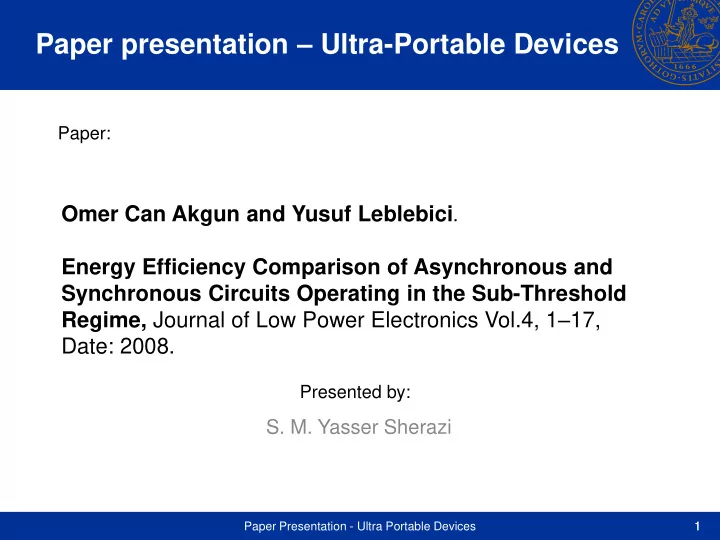

Paper presentation – Ultra-Portable Devices Paper: Omer Can Akgun and Yusuf Leblebici . Energy Efficiency Comparison of Asynchronous and Synchronous Circuits Operating in the Sub-Threshold Regime, Journal of Low Power Electronics Vol.4, 1 – 17, Date: 2008. Presented by: S. M. Yasser Sherazi Paper Presentation - Ultra Portable Devices 1 1
Outline • Introduction. • Motivation and Background. • Sub-threshold Energy Consumption Model. • Architectural Improvements. • Conclusion. Paper Presentation - Ultra Portable Devices 2 2
” Introduction ” • Power density and power consumption of digital sytems are a major concern • Any significant reduction in power consumption can only be achieved by lowering the operting voltage • The supply voltage is scaled such that the transistors operate in sub-threshold mode (weak inversion) • Sub-threshold operation of static CMOS logic was analyzed using EKV model • Static CMOS can be operated with supply voltage as low as 50mV at ambient temperature • Circuit working at these extreme low voltages work at much lower speeds. Paper Presentation - Ultra Portable Devices 3 3
’’Motivation and Background’’ µ is the mobility of carriers, C ox is the gate oxide capacitance per unit area, U t is the thermal voltage whose value is 26 mV at 300 K W/L is the aspect ratio of the transistor. Paper Presentation - Ultra Portable Devices 4
”Effects of Process Variation on Sub - Threshold Operation” Paper Presentation - Ultra Portable Devices 5
”Asynchronous Operation” Paper Presentation - Ultra Portable Devices 6
”Asynchronous Operation” Paper Presentation - Ultra Portable Devices 7
”Asynchronous Operation” Paper Presentation - Ultra Portable Devices 8
”Asynchronous Operation” Paper Presentation - Ultra Portable Devices 9
”SUB -Threshold Energy Consumption Model” • Assumption-1 : As soon as the asynchronous block finishes processing the current data, a new data input can be applied, i.e., there is no idle time between data inputs to the asynchronous block. • Assumption-2 : The energy consumption and processing delays of the circuit per computation are randomly distributed. This assumption is guaranteed by applying a randomly distributed data set to the input of the circuit. • Assumption-3 : Synchronous circuits work at their maximum speed, i.e., clocked at a speed equal to their critical path delay. Paper Presentation - Ultra Portable Devices 10
”SUB -Threshold Energy Consumption Model” Paper Presentation - Ultra Portable Devices 11
’’Energy Model’’ e i is a scaling parameter that defines the switching property of the circuit C tot is the maximum possible switched capacitance of the circuit, µ e is the mean K cap-logic = C tot /C inv K leak is average leaking factor Paper Presentation - Ultra Portable Devices 12 12
’’Energy Model’’ d i is a scaling parameter that defines the delay properties of the circuit processing the current data, k crit is a coefficient that defines the critical path delay of the circuit in terms of the inverter delay T sw_inv is the delay of an Inverter µ d is the switching mean k comoh is a parameter defining the overhead caused by the asynchronous communication in terms of the critical path delay of the purely combinational logic block Paper Presentation - Ultra Portable Devices 13 13
’’Energy Model’’ Asynchronous Synchronous Paper Presentation - Ultra Portable Devices 14 14
’’Energy Model’’ 15
’’Energy Model’’ Paper Presentation - Ultra Portable Devices 16 16
’’Energy Model’’ Paper Presentation - Ultra Portable Devices 17
’’Real - World Application Comparison ’’ Paper Presentation - Ultra Portable Devices 18
’’Real - World Application Comparison’’ Paper Presentation - Ultra Portable Devices 19
’’Real - World Application Comparison’’ Paper Presentation - Ultra Portable Devices 20
’’Real - World Application Comparison’’ Paper Presentation - Ultra Portable Devices 21
”Synthesis Results Based Model Accuracy” Paper Presentation - Ultra Portable Devices 22
”Synthesis Results Based Model Accuracy” Paper Presentation - Ultra Portable Devices 23
”Architectural Improvements” • Parallelism Paper Presentation - Ultra Portable Devices 24
”Architectural Improvements” Paper Presentation - Ultra Portable Devices 25
”Architectural Improvements” • Pipelining Paper Presentation - Ultra Portable Devices 26
”Architectural Improvements” Paper Presentation - Ultra Portable Devices 27
”Architectural Improvements” Paper Presentation - Ultra Portable Devices 28
”Architectural Improvements” Paper Presentation - Ultra Portable Devices 29
”Architectural Improvements” Paper Presentation - Ultra Portable Devices 30
”Architectural Improvements” 31
”Architectural Improvements” 32
”Architectural Improvements” 33
Conclusion • The energy model presented is highly aqurate and efficient • Pipeling helps is reducing the energy cost. • Parallel processing in sub-threshold domain does not reduce the energy dissipation. 34
Recommend
More recommend